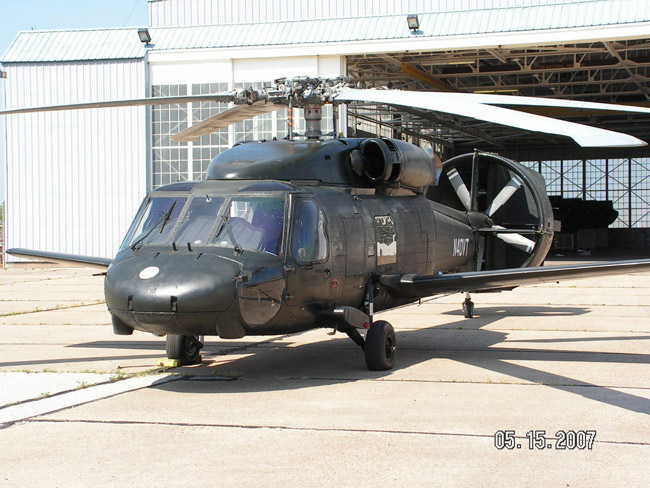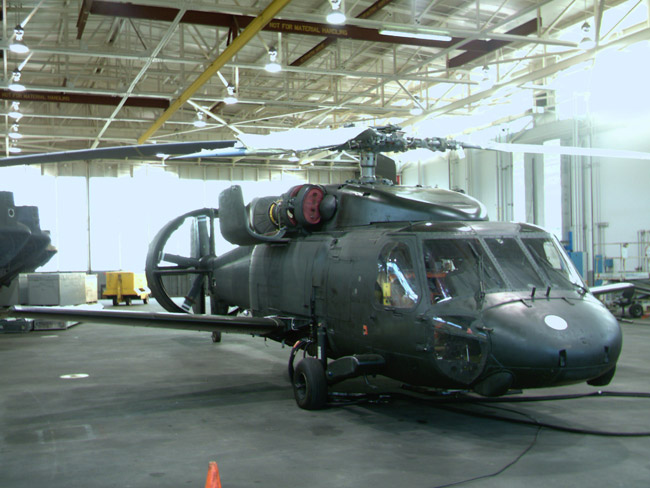Piasecki Aircraft is preparing its X-49 experimental compound helicopter for a first flight before the end of June. [Source]
The modified Sikorsky H-60, with wings and tail-mounted variable-thrust ducted propeller (VTDP), has been moved to Boeing’s Wilmington, Delaware facility for ground and flight testing.


The X-49A “Speedhawk” is an experimental helicopter currently under development. It is the subject of a $US 26.1-million U.S. Navy-sponsored project that consists of a Sikorsky YSH-60F helicopter modified by Piasecki as a testbed to test the “Vectored Thrust Ducted Propeller” (VTDP) system. One YSH-60F will be converted to test the feasibility of VTDP under an advanced technology demonstration program. The YSH-60F is powered by two General Electric T700-GE-401C engines.
The demonstration contract was awarded in October 2000 by the Naval Air Systems Command to Piasecki Aircraft. Piasecki will install a lifting wing with flaperons and a vectored-thrust ducted propeller (VTDP), or “ring tail,” to a U.S. Navy Sikorsky YSH-60F.
The compound helicopter technology that will be added to the YSH-60F was first demonstrated in trials of the Piasecki 16H-1 and 16H-1A in the early 1960’s, when the helicopters were flown at speeds up to 225 mph (360 km/h).
The X-49A YSH-60F flight demonstrator will be updated with a lifting wing taken from an Aerostar FJ-100 business jet. A ring tail will also be added and the helicopter drive train will be modified to accommodate VTDP. Piasecki will conduct integrated tests of the modified drive train at the Navy’s helicopter transmission test facility.
The cockpit controls will be modified with the addition of a manual prop pitch override on the collective for the ring tail. This will be the only visible change to the aircraft’s existing mechanical controls in the cockpit. The other controls needed to operate the compound helicopter’s systems will be integrated into the aircraft’s existing mechanical controls to reduce pilot workload. Weight added to the X-49A YSH-60F will be about 1,600 lb (725 kg). It will have an unrefuelled combat radius of 1,411km following a rolling take-off, and 963km after a vertical take-off, representing a three-fold increase over the standard H-60.
As of 2004 the X-49A YSH-60F/VTDP demonstration program was being transitioned from the U.S. Navy to the U.S. Army.

UGLY!
kinda cool, though not real practical…
Outstanding! If they can get the speed over 200 Kts, it will be a terrific low cost alternative to the tilt rotor for a high speed insertion and extraction of Special Forces teams, Combat SAR for downed aviators and many other missions requiring a hovering capability where time and range is of the essence to mission success.
beagle pilot, the wings might make getting in and out in a hurry kinda difficult.
It’s a solution to a problem that no-one has been talking about. Groovy aircraft though. I can’t see what sort of mission this aircraft would fulfil, though. The V-22 fits any mission profile that the Speedhawk could carry out, and the tilt-rotor system is a more elegant solution….
Hotrod, tilt-rotor is also a very problematic, complex solution, plus Speedhawk is smaller and presumably a little more versatile
Granted, but the USMC seem to be making good use of the Osprey! I really cant see the point of the Speedhawk, apart from looking extremely cool, because the wings preclude most evac missions and the ducted tailfan would be noisy as all hell as well as blowing crap all over the shop. I mention the evac mission as the CSAR-X program is in trouble and I could see the Speedhawk being a new contender in it, with suitable development…
You know, the statement about how “complex” Tilt-Rotor is keeps cropping up, but is it so? The Speedhawk concept frankly doesn’t seem to be any less complex. You’ve got all the complexity of a conventional helo plus the auxiliary propulsion system and thrust diverter for anti-torque. In addition you have to deal with the issue of rotor tip speed at these higher velocities as well as retreating blade stall at above 200 knot speeds. The concept has been mooted as a way to get increased speed out of existing rotorcraft in lieu of developing a whole new aircraft. Maybe so, but this guy has been around for quite a while and so far has not flown faster than a clean H-60 without all the extra gear.
I frankly don’t see how Tilt-Rotor is “more complex” than other advanced rotorcraft, and so far it’s been more successful.
more successful? look, don’t get me wrong, i love the tilt-rotor concept, and the Osprey in particular, but the Osprey has been having development problems for decades, and the Marines were forced to drop their autorotation requirement due to, idk, probably cost overruns or technical difficulties. and yes, Speedhawk is also probably complex, but if you have two rotating rotors that have to be perfectly synchronized, and the wing swivels, and the gun doesn’t have clear fields of fire out the back until the ramp until it fully opens, and… those are critics arguments. true, Osprey is probably better, and for sure farther along, but Speedhawk might work well in high-speed insertions in crowded environments (it’s thinner)
i work at hurlburt field on the gunships here, also where the ospreys are coming in, and from what i here from the other maintainers, they are very problematic. the speedhawk is cheaper (you dont even have to make a completely new body style for it, since it’s just a modded sh-60) less complex hydraulic wise, and less accident prone (often have i heard the engines swinging down from up and safe while maintenance was being conducted) although i am a little biased since my step father is working in the speedhawk project and seen to many accidents with the ospreys than i would have liked.
hotrod, the tailring is ducted, so it can be channeled or increase/decrease power coming from it, so the noise and “blowing things everywhere” is manageble. currently the only negative thing to come from the modified sh-60 is it’s weight placement: it’s rear heavy, all the added weight is added to the helo’s center of balance and the tail, nothing added to the front. i remember seeing a video of it’s first flight and watching the tail bouncing on the pavement. the engineers are trying to solve the problem by moving the rotor a few feet back. but in time we will see how well it works out.
@ A1C PERRY: Thanks for the comment. It’s much appreciated!
anything your stepfather can say about the Speedhawk project?
i’ll call him later this week, if anything i can post more information about it that i know about (note my step dad works there, i dont, so i dont know everthing)
although i do know they are fighting with the pilot (common case) where the pilot wants to fly it to much, and it will stress the aircraft especially since its unfinished. but seeing it fly is neat regardless.
A1C Perry, thanks for offering a different point of view. I’m afraid I disagree with you about the ducted fan, though! It will blow stuff everywhere, especially if it was deployed in a desert region. To make a comparison – remember the Chaparral Can-Am racer driven by Vic Elford in the 70s? That had two fans to suck the car down. Drivers behind him complained of stones and dirt thrown at them from the fans. The same thing happened with the Formula 1 Brabham “fan car” which had a large fan on the back of it. Drivers following it…………….etc.
And I still don’t think it REALLY has a purpose apart from being very groovy looking. By the way, is there any news on how the CSAR-X programme is progressing?
well no point in argueing about opinions, but i do have some news, the project is going to phase 2 as of next week. this is where they simplify the “ring-tail” thus lowering weight and ducting complications, also in this phase they are taking the steps to move the rotor back a few feet, by how much? i dont know im not an engineer. as well as the winglets will no longer be on the lower half of the aircraft, but on the upper part much like a little cessna plane.
as a side note, they have started working a similar design into a h-1 in hopes of getting the marines to buy into this as well seeing that the army has a large interest already.
you mean they’re turning a Huey into one of these? isn’t the bird too old?
Maybe they will bung it on the back of a UH-1Z… Although I would have thought it would be of more use as a system on an AH-1 myself…
That copter looks bad@$$ and I sure hope it can and will fly bad@$$!!! Maybe it will help with ideas for my inventions. 5/29/08, 8:20 am i5 years old.
It was once said that filling tyres with air was a waste of time and had no purpose. Lets not stand in the way of evolution. Let it roll baby.
So long as I have controllability at a hover, I’d love to be able to increase my forward airspeed and maneuvering margin as significantly as this new system indicates. I think it’s very promissing, and would love to see it effectively implemented on my 64.
The plane has flown over 80 hrs. It also has wings with full-span flaps, so blade stall is a moot point. This is a test bed airplane, not a production design.